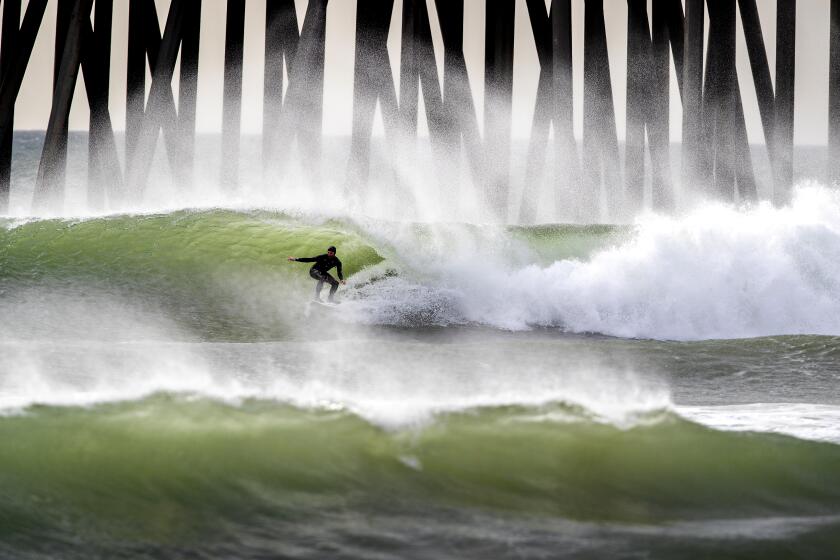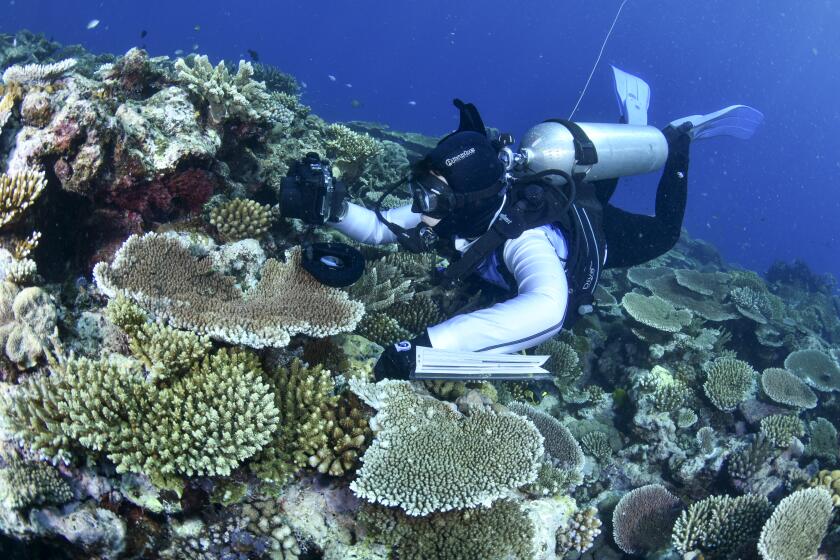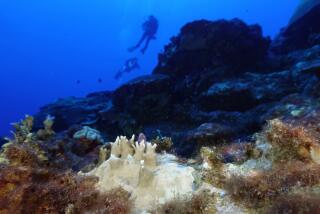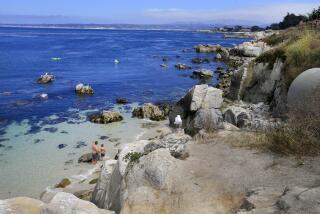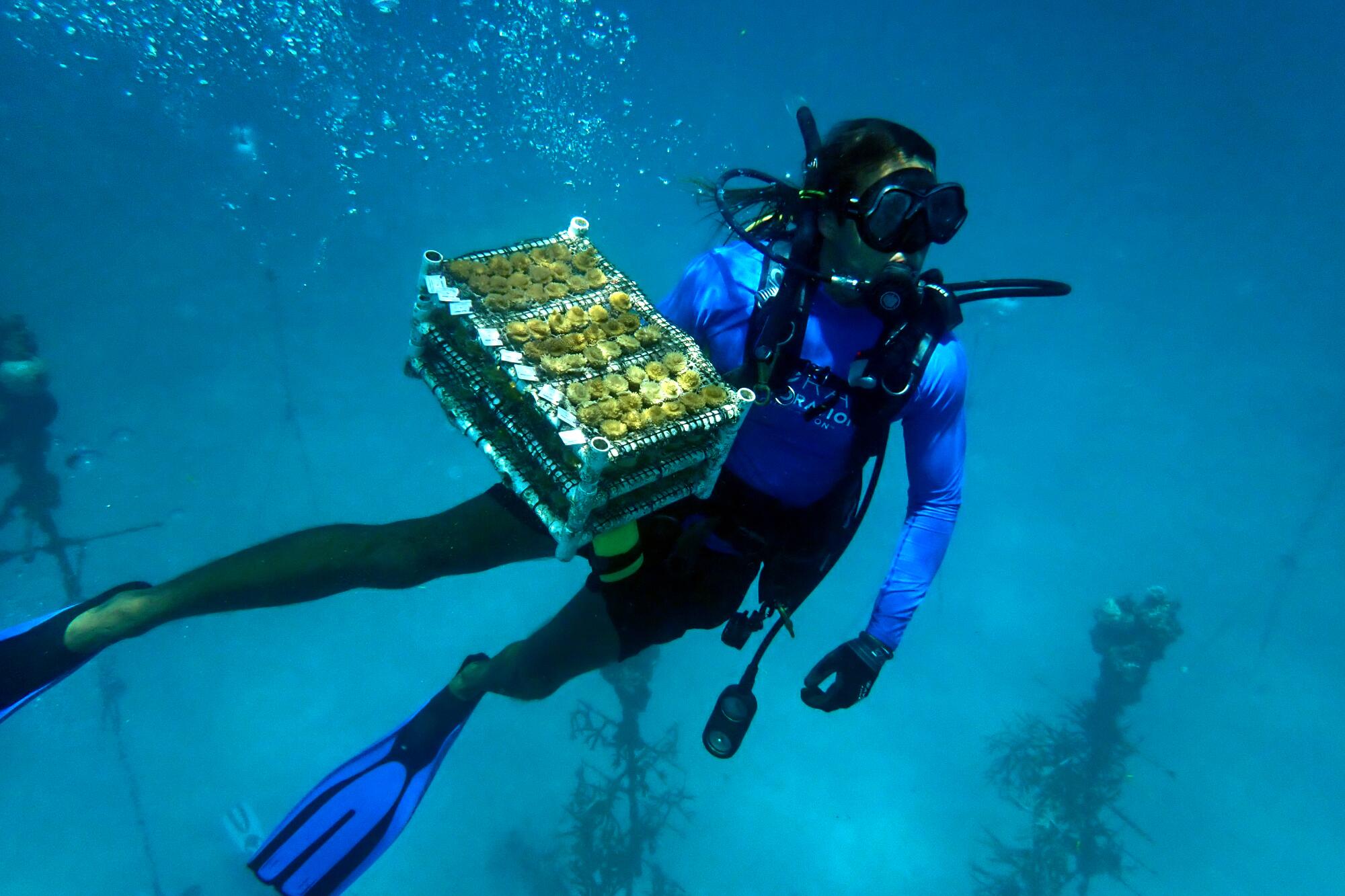
ALLIGATOR REEF, off the Florida Keys — Three and a half miles off the Florida Keys, Kylie Smith kicked to the surface of the ocean, then looked back down through her scuba mask to confirm what she had seen in the coral reef 15 feet below.
A colony of baby elkhorn coral was bone white. Another grouping of the animals was dying from rapid tissue loss disease. Smith’s team of volunteers had planted the baby coral in the last year and watched them thrive. Now both colonies — which had slowly spread, with tiny nubs reaching toward filtering sunlight — were being damaged as water temperatures spiked.
“It’s heartbreaking,” the 34-year-old coral ecologist said softly, cupping her hands around her scuba mask as she bobbed in the waves above Alligator Reef.
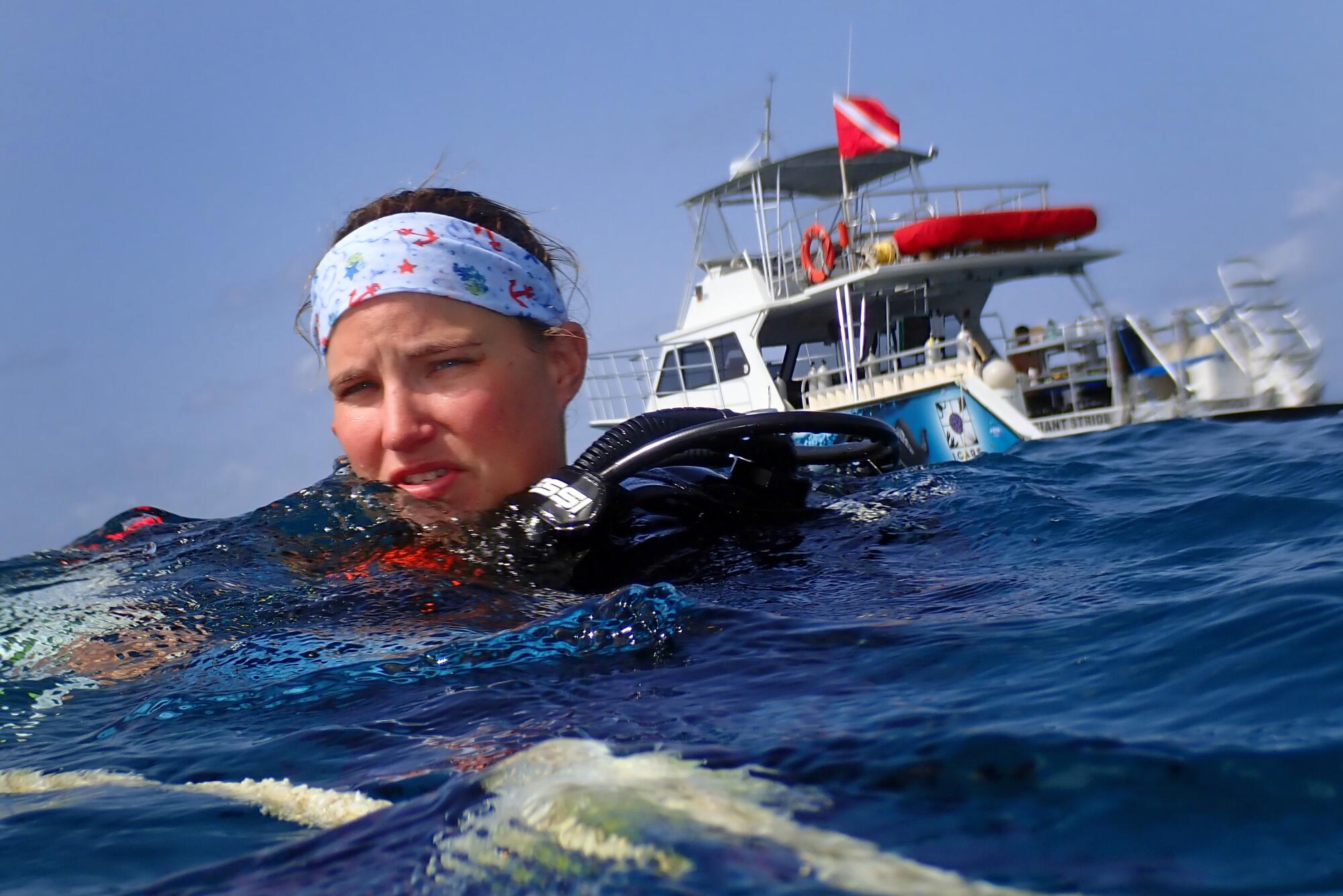
As ocean temperatures rise to historic levels for July — a buoy in the shallow Florida Bay recently registered 101.1 degrees at the surface — corals are bleaching along Florida’s fragile 350-mile-long barrier reef. At the bottom of some of the reefs that make up the barrier system, the only one in the contiguous United States, temperatures have reached 93 degrees, more than 6 degrees higher than is average for the time of year. Without major human intervention, some species of the ancient marine animals, vital to thousands of species of sea life and the region’s economy, risk extinction.
Up and down the coast, divers are scrambling to monitor corals — some recently planted on the ocean floor, others that have thrived for thousands of years. A network of scientists and coral restoration experts is also racing in a modern-day Noah’s Ark-style mission to haul specimens to safety before they perish. Some are afraid to open their eyes when they near the bottom.
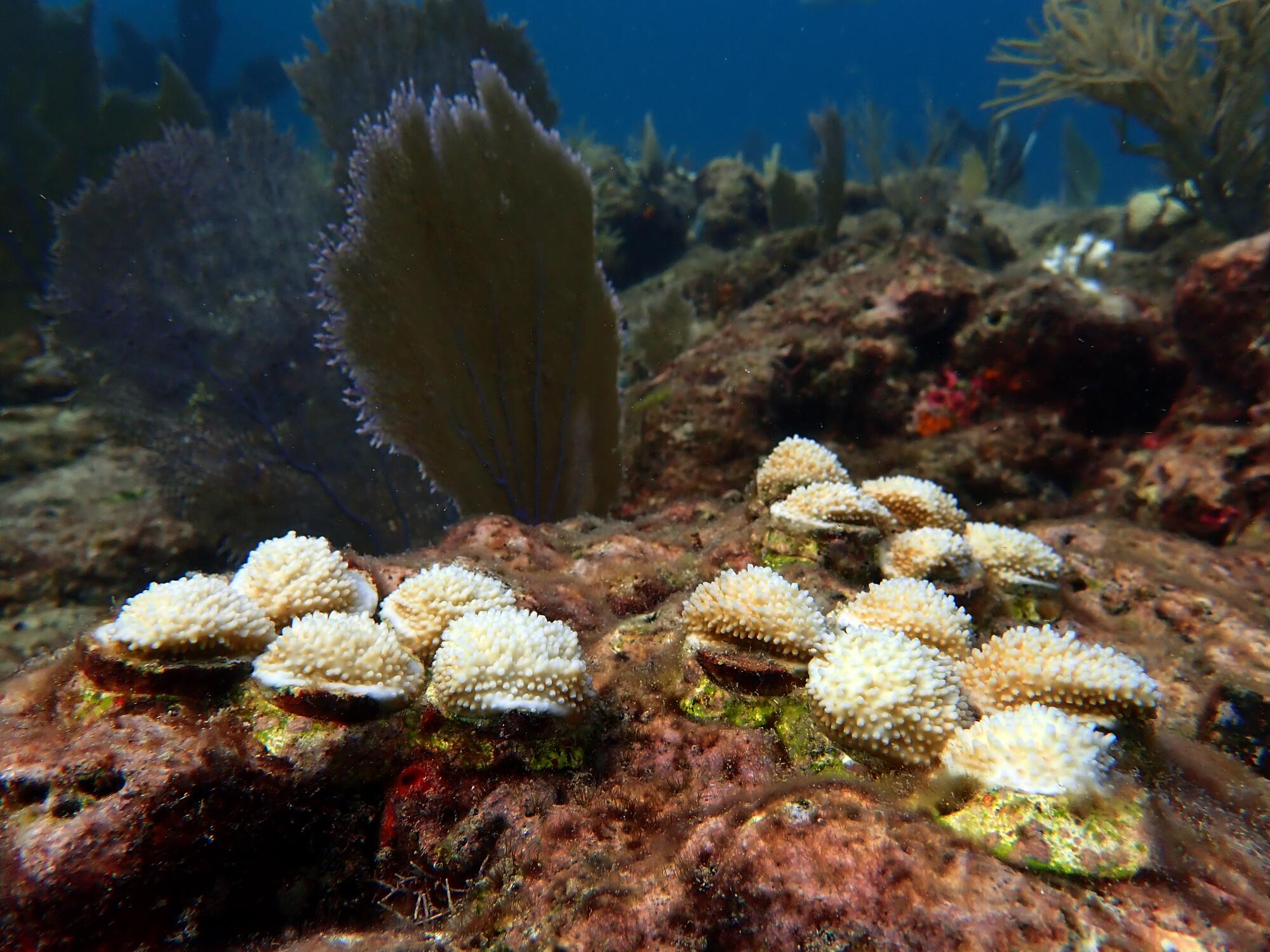
Smith, a co-founder of I-CARE, a group that trains and organizes recreational divers to plant corals that have been raised in nurseries, has already mourned the death of one of her prize specimens: an elkhorn that had fused together from several pieces little bigger than a quarter to form crowns branching up to 10 inches.
But Smith, who got certified as a diver at 15 to overcome her early terror of watching “Jaws,” was not dwelling on her losses. Her group has planted 14,684 corals in the reefs along Florida’s Upper Keys in the last 2½ years, more than a quarter here in Alligator Reef, and she had more to check on.
“Let’s go see if we can find a happy one!” she said, kicking her fins and fluttering back down.
A hotter planet is generating more winter storms in the North Pacific Ocean, which in turn is producing taller waves, according to a new study. That could make coastal flooding and erosion even worse.
She neared what had been a promising colony of knobby brain coral, tiny and dome-shaped with undulating ridges. Smith circled the coral, which had been cared for in a nursery for two years and had been doing well since being transplanted in May. Now it was light and paling.
But a few feet deeper, she spotted a brain coral that was a healthy, greenish brown. Then, another cluster planted in May that was a little pale, but already starting to fuse.
Smith wasn’t sure what accounted for the variation in the slow-growing species. Maybe it was the deeper water. Maybe the corals that retained their color were more resistant to heat stress.
She swam on — past a turtle scratching its back near a cluster of completely bleached elkhorn — in search of corals that showed signs of resilience.
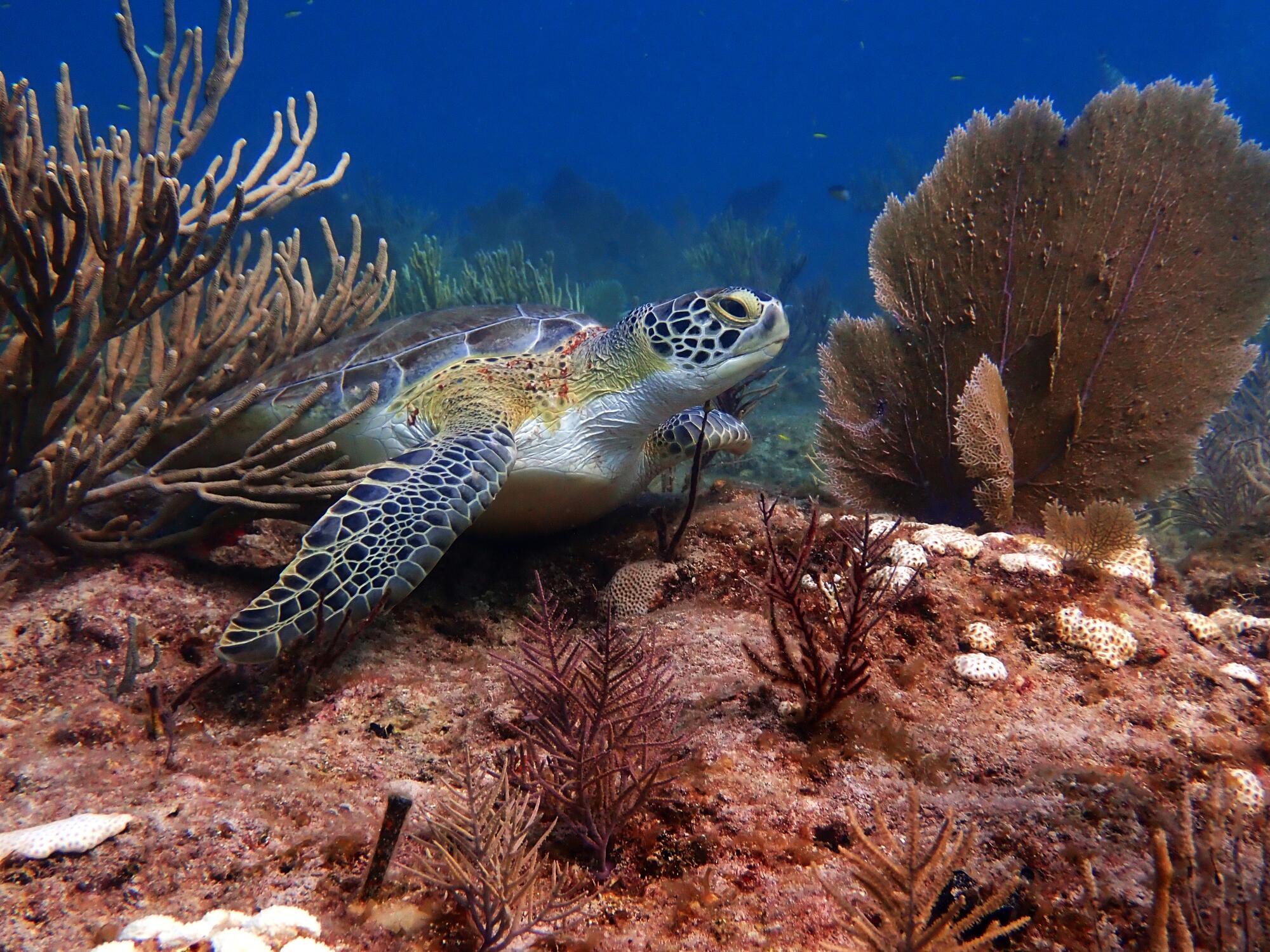
‘It’s been there for thousands of years’
Protecting and restoring the corals of Florida’s degraded barrier reefs is no easy task.
In the last four decades, this intricate stretch of shallow reef formations that came into existence around the last Ice Age has lost about 98% of its corals from a combination of polluted water, disease, abnormal ocean temperatures, overfishing and other human impacts.
Seven species of the coral found in Florida’s reef — elkhorn, staghorn, boulder star, mountainous star, lobed star, rough cactus and pillar — are listed as threatened under the Endangered Species Act.
This is not the first time corals in the Florida Keys have endured bleaching. When the water gets too hot, the tiny symbiotic algae that live in the corals’ tissues, zooxanthellae, turn excess energy from sunlight into dangerous toxins. The corals then expel the algae, their primary food source. Without the algae, corals turn white and are more susceptible to disease. Though corals can survive for a few days or weeks without the algae, they are less likely to recover from longer stretches of heat.
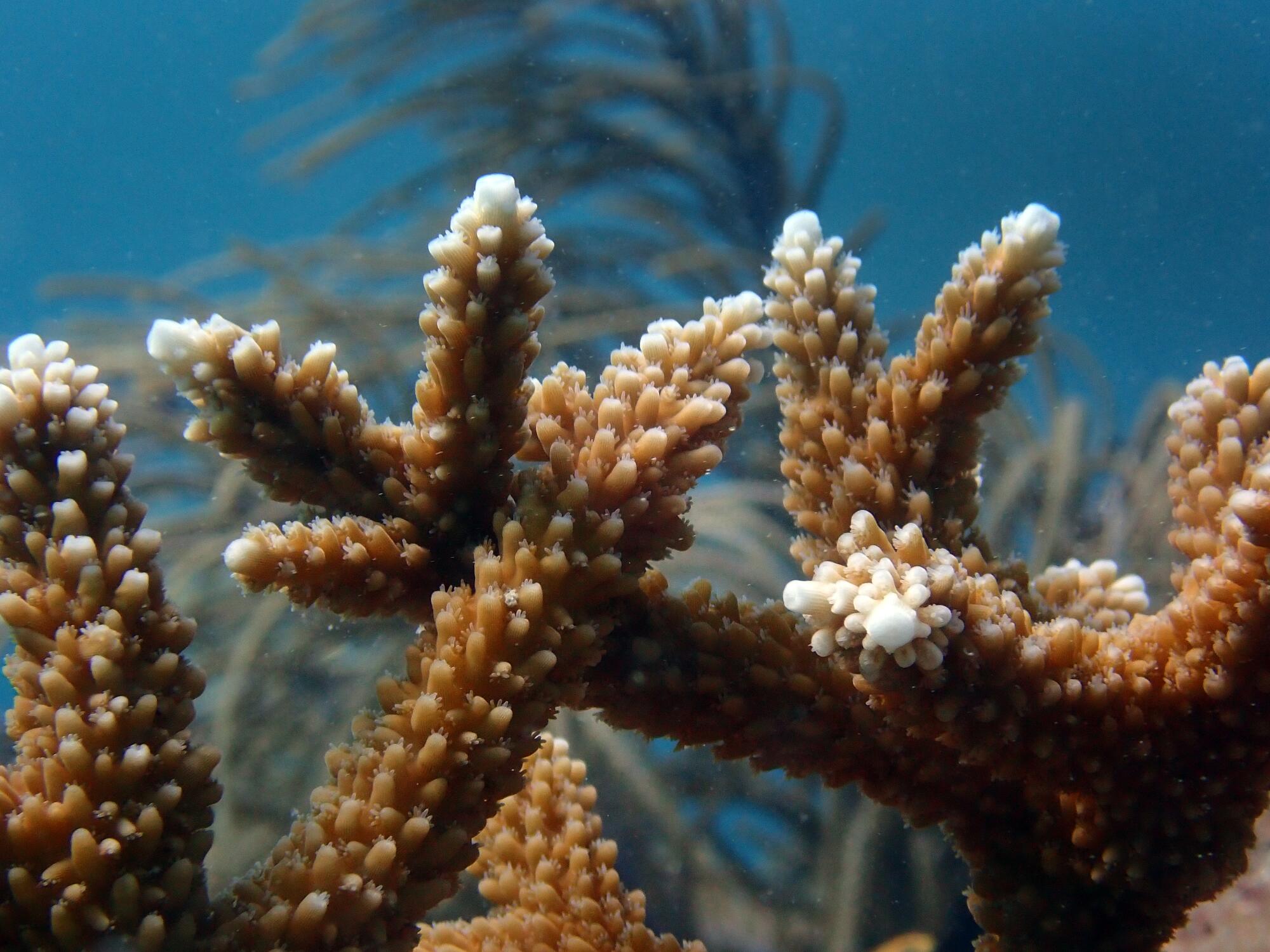
Mass coral reef bleaching events have risen steadily across the world in the last 40 years. A recent study found the annual risk of bleaching increased from 8% in the 1980s to 31% in 2016. In Florida, bleaching in the summer of 2014 harmed or destroyed a third of elkhorn corals at federal monitoring sites across the Upper Keys. What worries scientists now is that bleaching began in July — and August and September are typically the hottest months.
‘We’re the canary in the coal mine and the canary just died. It should be a huge wake-up call.’
— Ken Nedimyer
Last month, scientists with the National Oceanic and Atmospheric Administration raised their coral bleaching warning system for the Florida Keys to its highest heat stress level, warning of a 90% probability of bleaching through October.
Americans who have never gotten close to a coral on the bottom of the ocean might be surprised to find how much their lives are linked to the tiny marine invertebrates that form colonies and secrete calcium carbonate to form a hard skeleton. Corals perform a critical role for ocean biodiversity, making ecosystems that provide food and shelter for thousands of species of plants and fish, lobsters and sea turtles. They are vital to the Florida Keys’ economy, supporting commercial and recreational fishing and diving in a region where tourists contribute $2.4 billion in sales a year.
Coral reefs also provide a physical buffer between the land and sea, protecting eroding coastline from waves, storms and floods, and helping to prevent loss of life and property damage during hurricanes.
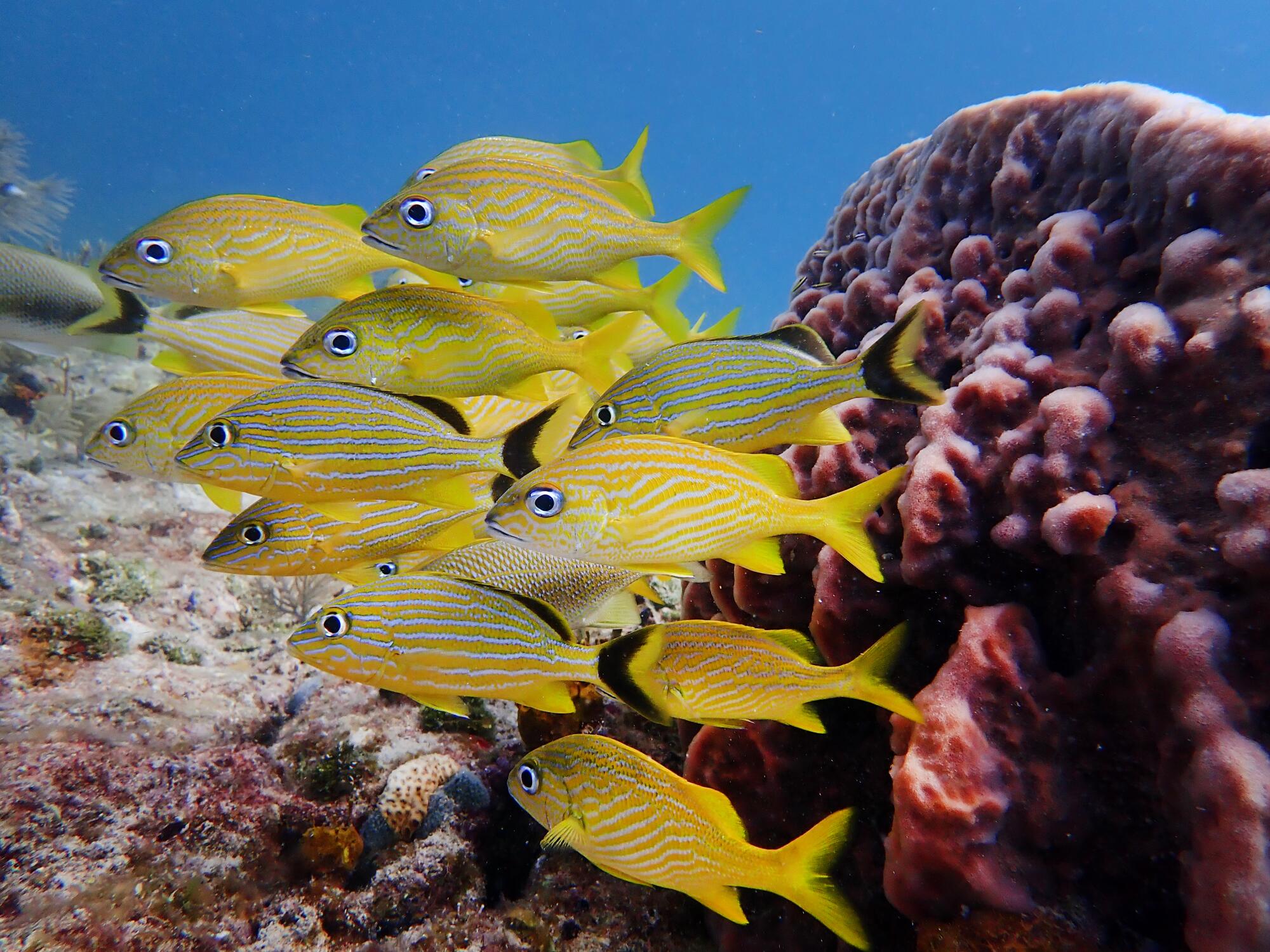
“It’s habitat for fish and invertebrates, it’s coastal protection,” said Ken Nedimyer, a pioneer of coral nursery and reef restoration techniques and founder of Reef Renewal, a consulting company that helps restore coral reefs.
“It’s just a magical world and to see it dying in front of you, and to see people not caring and not doing anything about it,” he trailed off, then sighed.
“The problem is somebody living in the middle of the country, they don’t see it,” Nedimyer said. “We’re the canary in the coal mine and the canary just died. It should be a huge wake-up call.”
Already, divers are reporting corals dying rapidly at locations such as Sombrero Reef and Cheeca Rocks. On July 20, a team from the Coral Restoration Foundation ventured to Sombrero Reef in the Lower Keys to collect tissue from wild elkhorn colonies to add to gene banks for safeguarding and found a graveyard of coral. Some cried into their dive masks.
Australian government scientists say 91% of the Great Barrier Reef coral surveyed this year was bleached in the fourth mass event in seven years.
“Unfortunately, they were already gone by the time we arrived,” Phanor Montoya-Maya, a marine biologist who is the restoration program manager for the foundation. “We lost unique individual genotypes that we don’t have copies of.”
While there is still hope for some reefs in the Upper Keys, where water temperatures are slightly lower than in the south, the corals in Sombrero Reef died so quickly they did not have a chance to bleach, Montoya-Maya said. Dead skeletons of the elkhorn corals were covered in algae, dust and sediment. Almost all the corals in the foundation’s Looe Key Nursery were also lost.
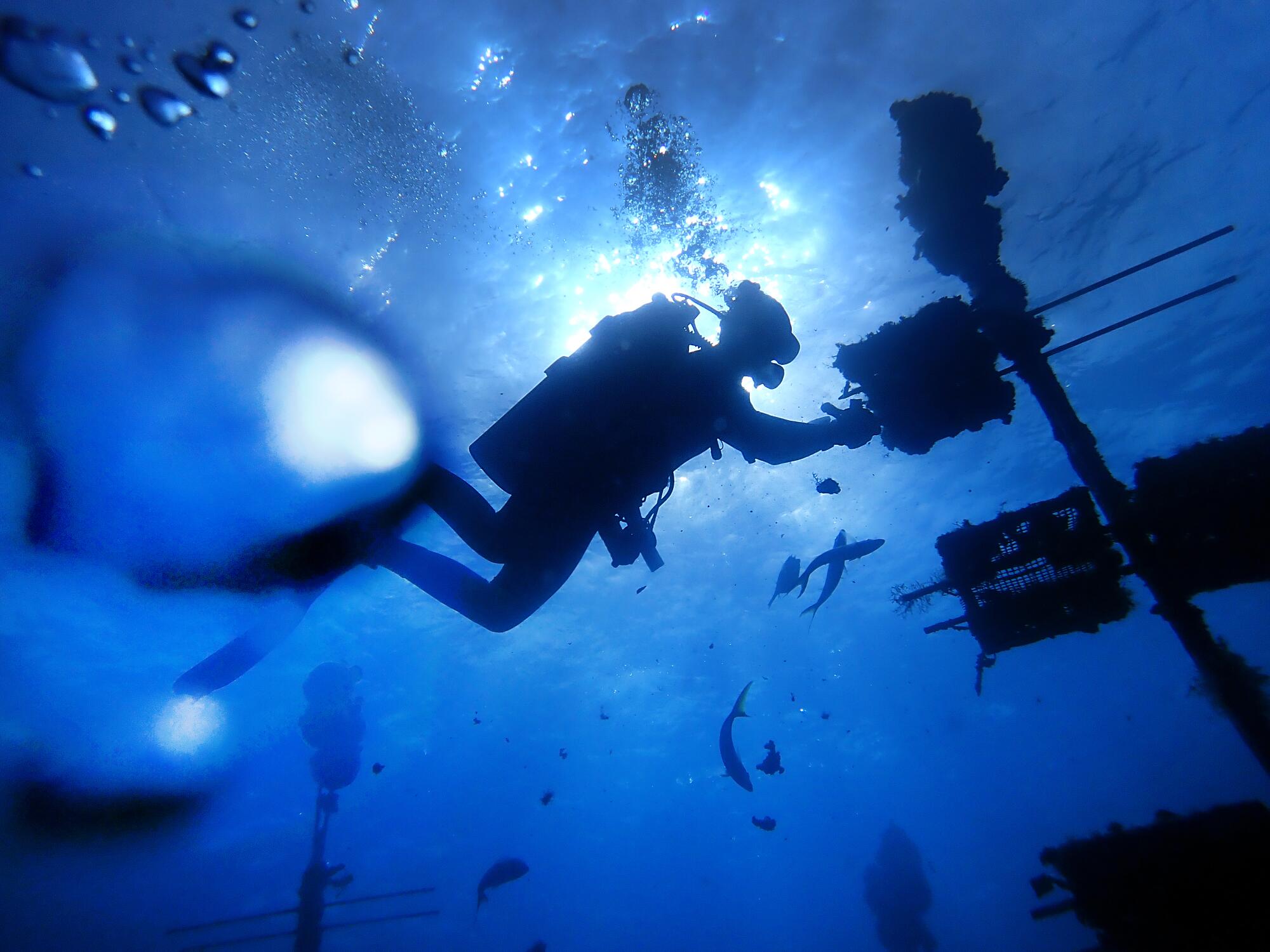
“It’s just, wow, every day, it’s a new horror story,” Nedimyer said. “Corals have gone from live to dead in a heartbeat, and it’s all over the place. It shakes you to your core. It’s rattling everybody.”
Venturing out recently to Horseshoe Reef — what he called a “hope spot” off the shore of Key Largo that has long been home to the Keys’ thickest patches of elkhorn and staghorn — Nedimyer expected the tops of the coral branches to be a little pale. All of the branches were stark white.
“Boy, oh boy, it could die,” he said, “which is just beyond belief, because it’s been there for thousands of years.”
A modern-day ark
In water so clear they appeared to be flying, a team of scientists wearing air tanks and fins glided one Sunday through the nation’s largest offshore coral nursery, plucking tiny fragments of coral and cradling them in the palms of their hands to an emergency staging room on the sandy, barren ocean floor.
The nursery, three nautical miles from the shore of Tavernier, Fla., is an otherworldly stretch of the ocean where tens of thousands of corals hang from 500 artificial “trees” made of PVC pipe.
The baby corals the scientists passed were shades of caramel, corn and honey. But many were starting to pale, and some showed signs of rapid tissue loss. A few were pure white.
Montoya-Maya, who was leading the expedition, knew he didn’t have much time.
“The objective for today is to rescue the genetic diversity that we have in our nurseries,” Montoya-Maya had told his team on the deck of the 46-foot dive boat Aquatic Liberty.
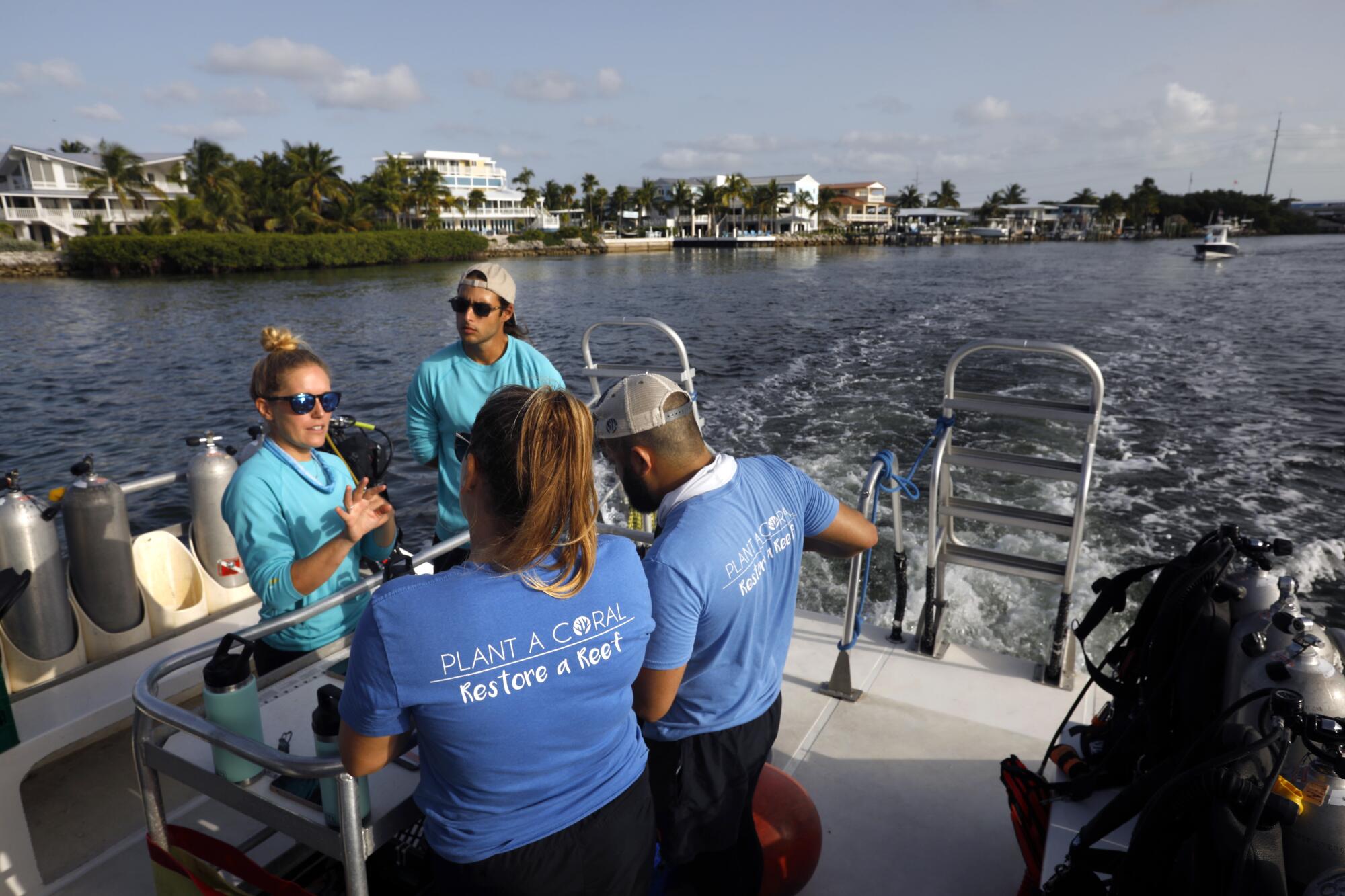
They were taking part in a massive operation, led by NOAA, to preserve the last remaining live elkhorn and staghorn corals from Florida’s coral reefs. Fragments from these genetically distinct coral types would be placed in land tanks in Sarasota and West Palm Beach that serve as modern-day arks for the vulnerable sea creatures. These living gene banks serve as an insurance policy so that surviving corals can serve as brood-stock for the next generation.
Peering through scuba masks at waterproof clipboards, the divers swam through schools of iridescent parrotfish and yellow and black striped sergeant majors as they tried to find specimens in the 1½-acre ocean nursery.

They had spent the last two days collecting pillar, brain and star corals. Their mission now was to collect hundreds of fragments of staghorn and elkhorn for NOAA’s gene bank, plus any other species they had time to collect.
As a shimmering barracuda hovered above, opening and closing its snaggle-toothed mouth as if marveling at the endeavor, a pair of scientists huddled on the floor, 30 feet below the ocean surface, holding tiny specimens that look like upturned fingers as they stuck them to epoxy.
They wrapped ID tags around the corals with monofilament fishing line and stacked them on trays.
“It’s a little like triage,” Montoya-Maya said. “We have too many, so the question is which ones do we save?”
After three 75-minute shifts underwater, the scientists floated back up, some balancing coral-filled trays like underwater waiters.
A team hauled the crates up to the Aquatic Liberty and set the corals in the shade. Montoya-Maya stacked the trays, one by one, in plastic bins filled with seawater, taking care to make sure they were stable. A few stowaway shrimp and octopus, who feed off the corals, were thrown back into the sea.
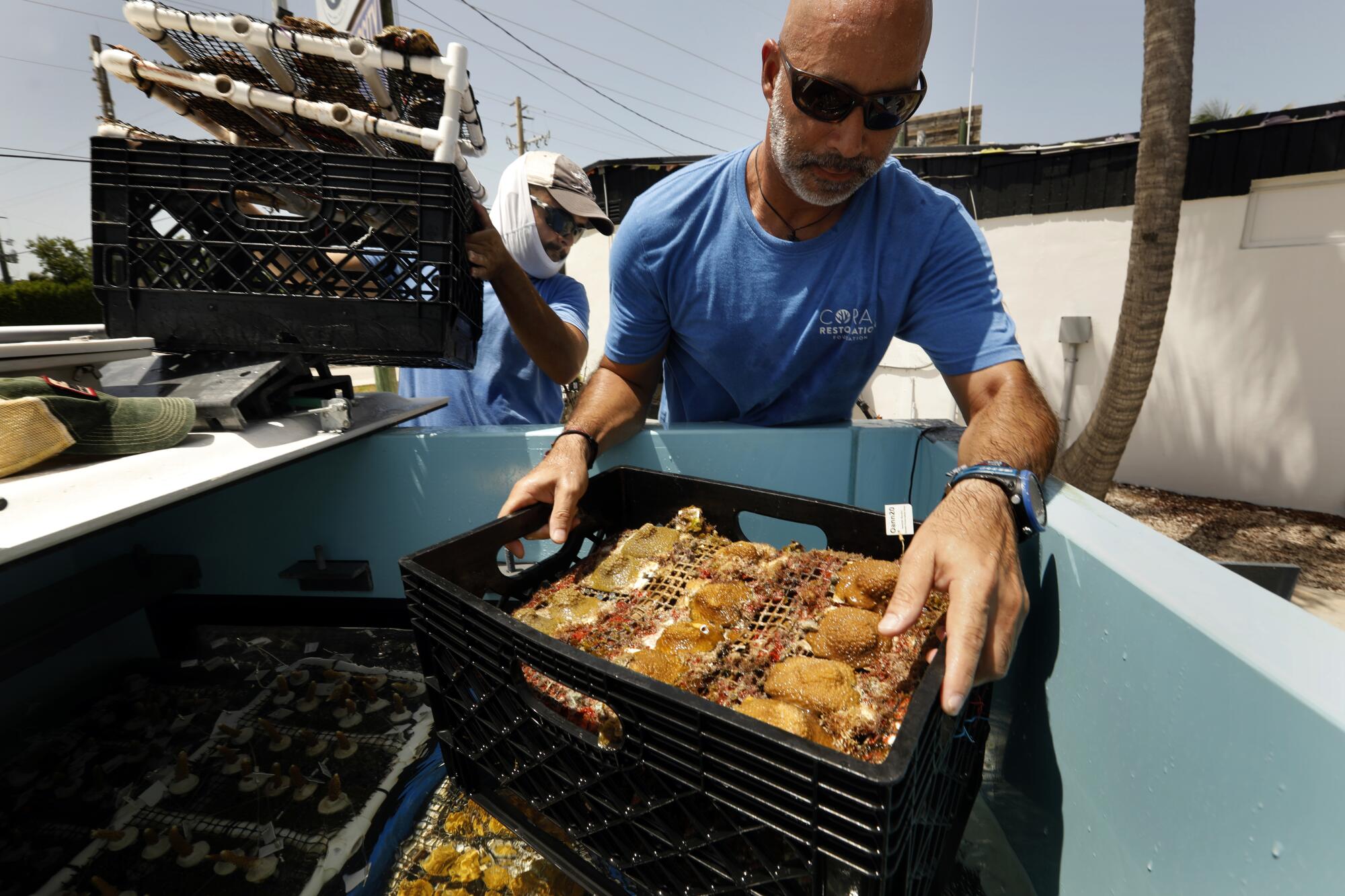
When they docked at the small town of Tavernier, the team hauled the coral fragments off the boat in the blazing heat. They began to stack them, tray by tray, in a “coral bus” — a state-of-the-art flatbed trailer specially designed to minimize stress to the corals, with an aquatic tank hooked up to a generator and conditioning unit to regulate water temperature, pH, filtration and water flow.
They had so many corals, they quickly ran out of room and piled the remaining trays into bins of sea water on the back of a pickup truck.
In one day, the team had collected 417 elkhorn and staghorns, representing 201 unique genotypes, for NOAA’s collection. They had also managed to save 472 reef-building corals such as brain, pillar and star.
Montoya-Maya got in the driver’s seat, waved to his team and drove the corals — now in slightly cooler 87-degree water — south on Highway 1 to the Florida Institute of Oceanography’s Keys Marine Lab, their temporary new home on land.
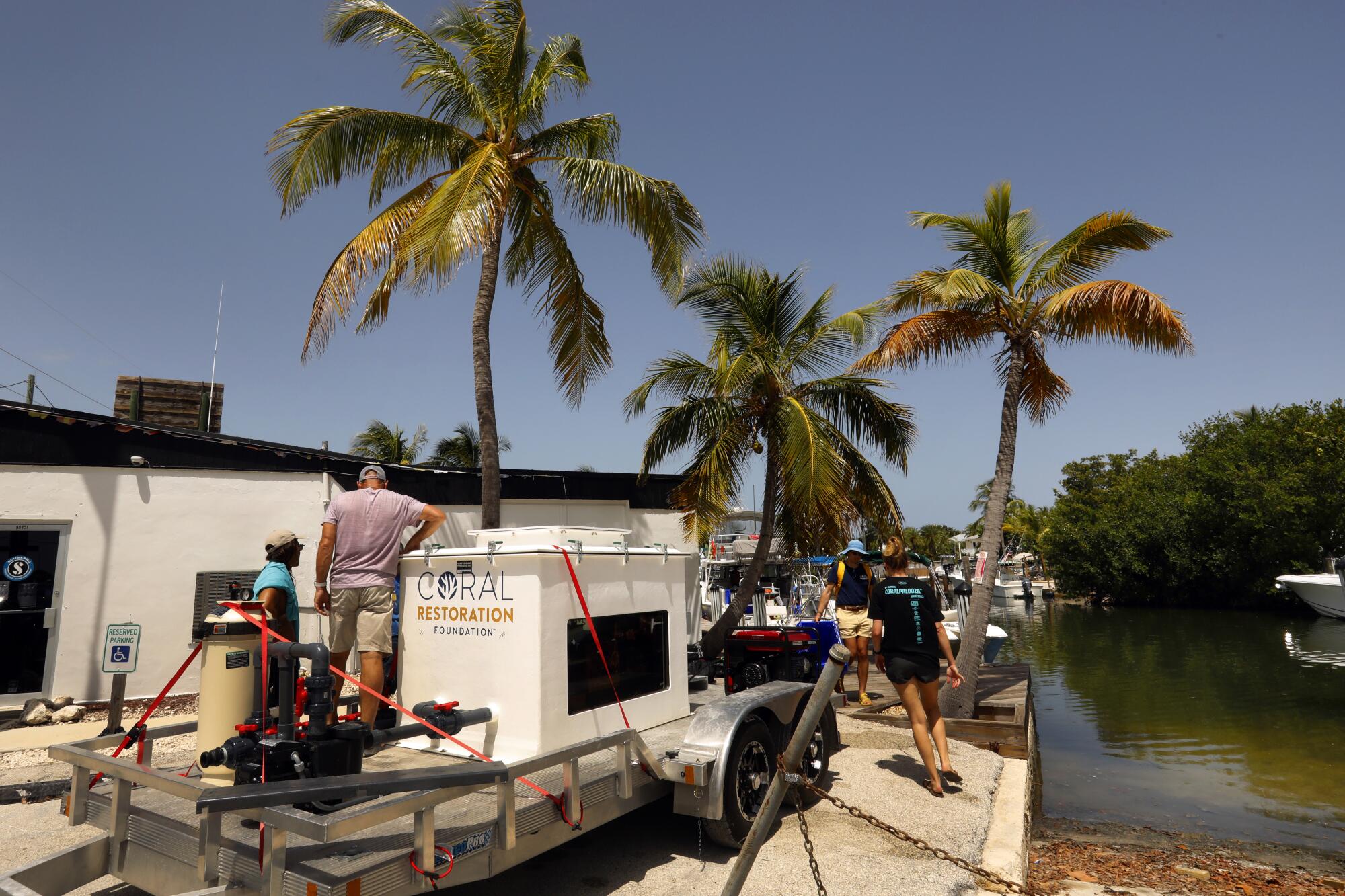
A handful of the elkhorn and staghorn did not survive the journey. But most of the corals recovered their color and would travel a few days later to their final destination: the Reef Institute in West Palm Beach.
Montoya-Maya’s mission was not over. After banking as much coral diversity as he could, his team shifted to another Herculean task: saving the 45,000 baby corals in their nurseries.
Creating resilience
Even as corals bleach, scientists who work in the cutting edge of coral restoration are optimistic about the future of Florida’s reefs. The extreme temperatures, they say, offer an important opportunity for research into resilience.
“As morbid as it sounds, it’s a natural experiment,” said Jason Spadaro, a biological scientist who manages the Coral Reef Restoration Research Program at Mote Marine Laboratory, an independent marine research institute.
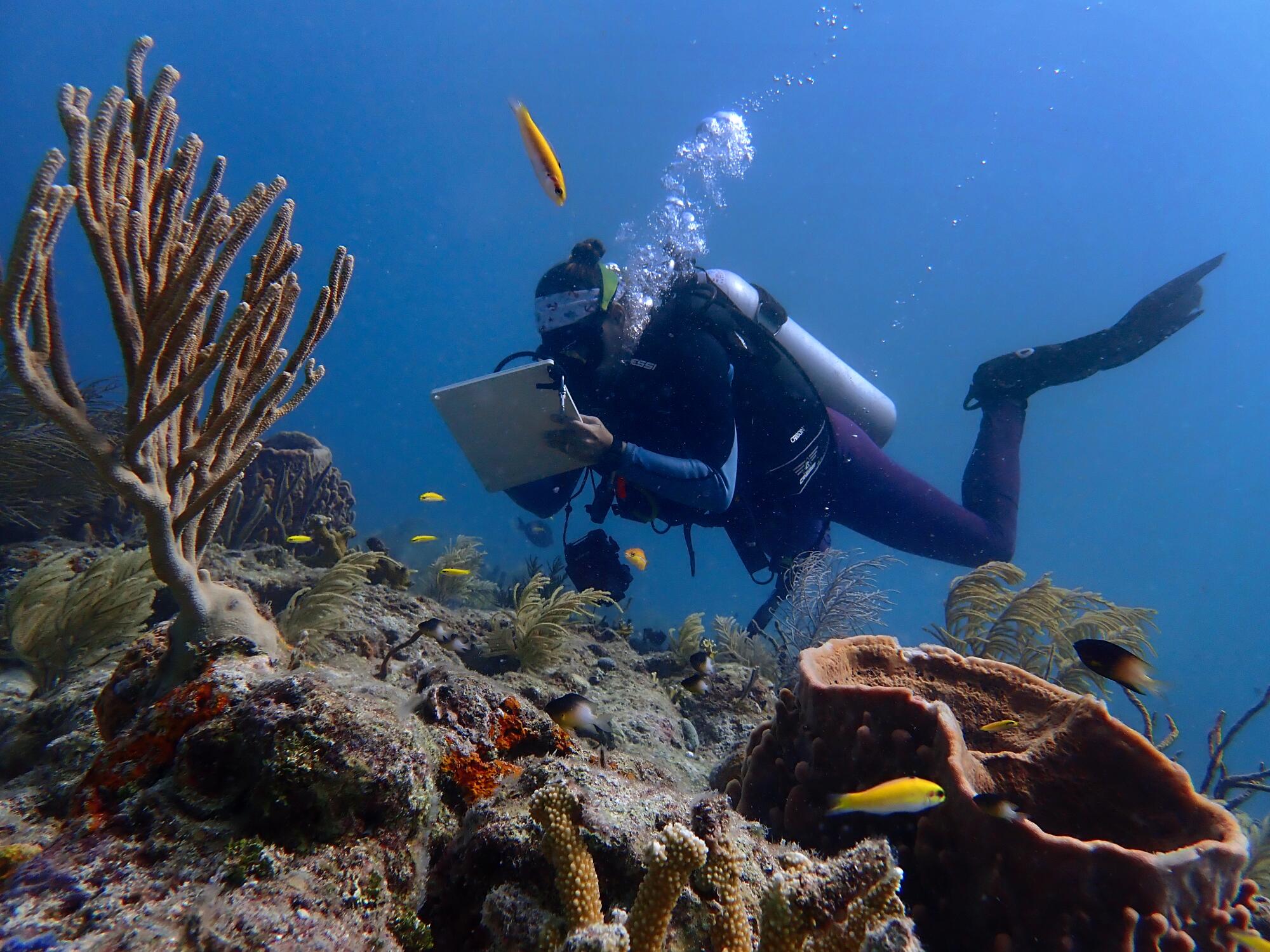
“While it is heart wrenching to see stark white corals, it’s also a major opportunity to look at how some of these resilient genotypes and some of these ones that we’ve suspected weren’t resilient respond to these really extreme conditions,” he said.
Over the last two decades, scientists and coral restoration experts have figured out how to breed corals by cutting them into tiny fragments. Using a process of micro fragmentation, scientists can spur corals to grow up to 50 times faster.
They have also developed sexual propagation labs in which they can trick boulder corals — such as brain and star corals, which typically spawn only six to eight days after the August full moon about three hours after sunset — to spawn multiple times a year.
Now Mote researchers are focusing on which genotypes are resistant to hot water and other challenges, so they can help breed corals that adapt to anthropogenic climate change.
The idea is that if one coral tolerates hot temperatures while another resists disease, sexually crossing both corals might produce a heat-tolerant and disease-resistant offspring. Mote’s long-term goal is to build a more resilient community that has the adaptive potential to handle the challenges of the new environment.

“Mother Nature can’t respond fast enough to this,” said Michael Crosby, Mote’s president and chief executive. “We’re just not going to hang our head in our hands and say, ‘Woe is me.’ We’re going to control what we can control, which is being really creative with science to develop the solutions to what is a reality: the warming of our oceans.”
In the short term, Mote is bringing critical colonies of corals that have taken years to grow to reproductive size to their land nursery for reproduction research. Its ultimate goal is to accelerate the reproductive process of resilient corals by planting fragments that can grow into fully sexually mature corals.
“That’s the Holy Grail,” Crosby said. “That’s what you want to be able to do: Help Mother Nature more rapidly repopulate with a genetic diversity of resilient genotypes that are spawning on their own, so that we put ourselves out of the coral restoration business.”
Asked if he had a timeline for ending his life’s work and putting his team out of business, Crosby said 20 years, maybe 10 with more money and trained volunteers to help transplant corals.
Eventually, Crosby said, Florida’s reefs could be like they were when he was a boy growing up in the Keys, with 60% living coral coverage.
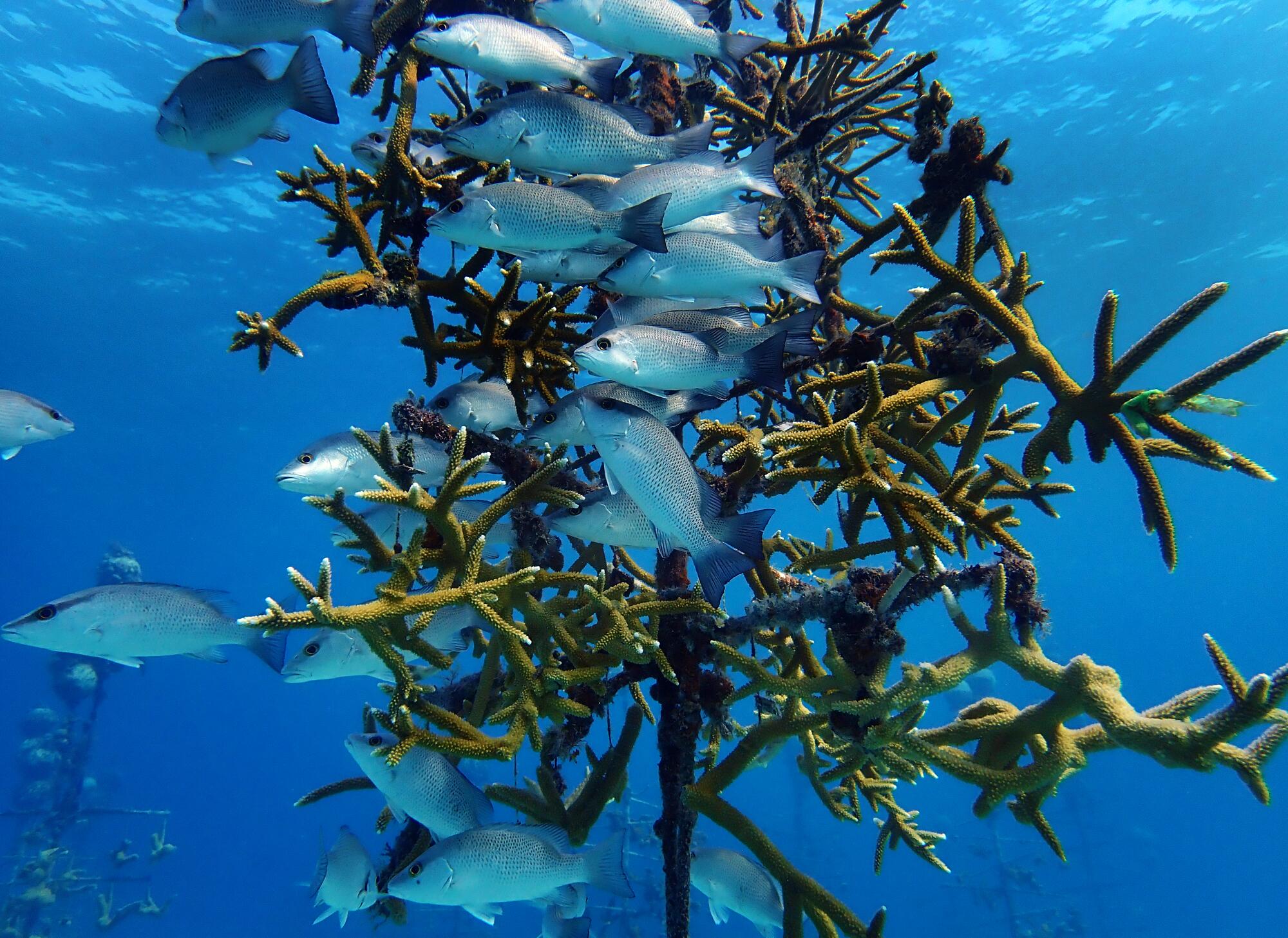
“If we can get up to a 20 to 30% living coral cover, then I think the coral reefs themselves can begin to take over in a more natural way.”
Now is not a time for doom-mongering, Crosby said. Thanks to scientific innovation, tiny fragments that would be more resistant to what killed the original could be planted on a dead 100-year-old coral head and, in five years, grow into a sexually mature coral that spawns in the wild.
“It isn’t about hope anymore,” Crosby said. “The science has demonstrated we can do this.”
More to Read
Sign up for Essential California
The most important California stories and recommendations in your inbox every morning.
You may occasionally receive promotional content from the Los Angeles Times.
